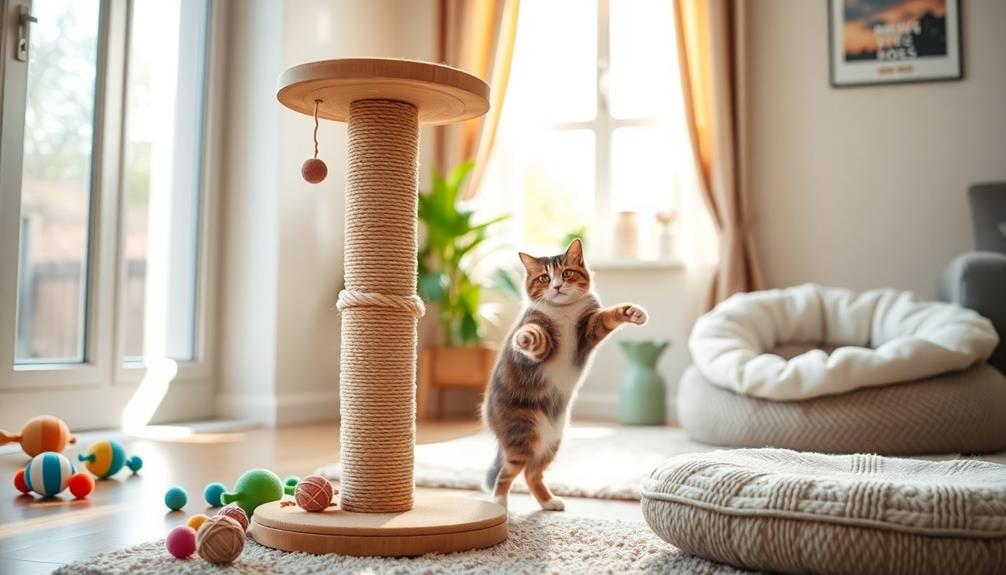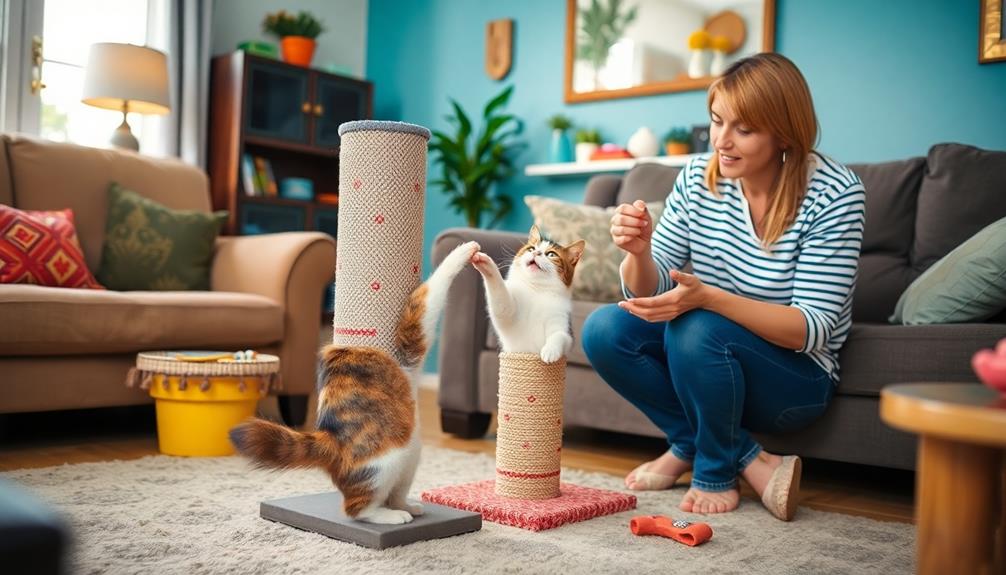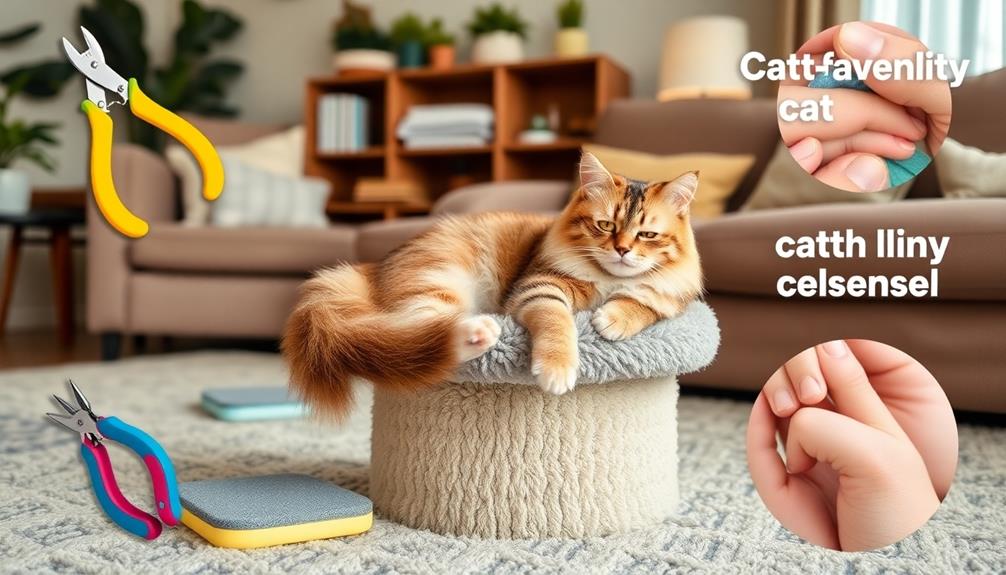To prevent your cat from scratching furniture, it is important to understand the reasons behind this behavior. Scratching is a natural instinct that helps cats maintain their claws and mark their territory. Offer suitable scratching posts made of sisal or cardboard near areas where they typically scratch. Use positive reinforcement such as treats or praise when they use the correct scratching surfaces. You can also deter unwanted scratching by using double-sided tape on furniture or sprays with unpleasant scents. By implementing these strategies, you can protect your furniture while meeting your cat’s needs. Learn more about effective management techniques here!
Key Takeaways
- Provide a variety of scratching posts with different materials and sizes to satisfy your cat's natural scratching instincts.
- Use positive reinforcement techniques, such as treats and praise, to encourage your cat to use designated scratching posts instead of furniture.
- Apply double-sided sticky tape or feline-safe deterrent sprays on furniture to create an unpleasant texture or scent that discourages scratching.
- Regularly trim your cat's nails to minimize damage to furniture and reduce the urge to scratch as a stress relief.
- Position scratching posts near frequently targeted furniture and use catnip to entice your cat to use them.
Understanding Cat Scratching Behavior
Understanding your cat's scratching behavior is essential for maintaining harmony in your home. Scratching is instinctive for cats, rooted in their survival instincts. It serves multiple purposes, from stretching to marking territory.
When your cat scratches, it's not just for fun; they're also maintaining claw health by shedding outer sheaths to reveal sharper claws needed for hunting. Additionally, just like primitive weapons for modern survival, scratching helps cats engage their muscles and maintain their physical condition. This behavior often starts in kittens as young as 8 weeks old.
Cats mark their territory both visually and chemically, using the scent glands in their paws. By scratching, they leave their scent behind, signaling ownership of an area.
Individual scratching preferences vary widely. Some cats love vertical surfaces like furniture and posts, while others prefer horizontal options like carpets.
Reasons Cats Scratch Furniture

Cats scratch furniture for several reasons that are deeply rooted in their instincts.
They're not just sharpening their claws; they're also marking their territory and releasing built-up energy from boredom or anxiety.
Additionally, providing alternatives, such as scratching posts, can help fulfill their natural behaviors while protecting your furniture.
Understanding these motivations can help you find better ways to redirect their scratching behavior, as seen in Ultimate Hamster Care Guide on the importance of providing appropriate outlets for pets.
Natural Instincts and Behavior
Scratching furniture is a natural behavior for your feline friend, serving several important purposes. For cats, scratching is essential for maintaining claw health; it removes old nail sheaths and reveals sharper claws.
This instinctive behavior also allows your cat to fully stretch, relieving muscle tension and promoting overall fitness. Providing healthy dog snacks can be a great way to keep your pets engaged and happy, just as offering appropriate scratching surfaces can do for your cat.
Every cat has its own preferred scratching surfaces. Some may favor vertical options like cat trees, while others might prefer horizontal scratching posts. Understanding these preferences can help you provide suitable alternatives that keep your cat engaged and away from your furniture.
Additionally, scratching can be a sign of boredom or anxiety. If your cat is scratching excessively, it might indicate that they need more environmental enrichment, like toys or interactive playtime, to keep them stimulated.
Territory Marking Purpose
Marking territory is one of the key reasons your cat enjoys scratching furniture. This scratching behavior is instinctual, rooted deep in your cat's wild ancestry. In the wild, cats scratch to establish their presence, leaving both visual marks and chemical signals through scent glands in their paws.
When your cat scratches a piece of furniture, it's not just damaging it; it's also claiming ownership of that space.
In multi-cat households, this behavior becomes even more pronounced. Your cat uses scratching to communicate with other cats, signaling that the area is occupied and deterring potential intruders. The visible scratches serve as a territorial boundary, reinforcing their claim over the environment.
To satisfy this natural instinct, consider providing designated scratching posts in your home. By placing these posts in areas where your cat frequently scratches, you can redirect their territory marking purpose to more appropriate surfaces.
This not only protects your furniture but also allows your cat to express their natural behaviors in a positive way. Understanding these motivations can help you create a harmonious living space for both you and your feline friend.
Anxiety and Boredom Factors
Understanding the reasons behind your cat's scratching behavior can reveal underlying issues like anxiety and boredom. When you notice your cat scratching furniture, it might be a sign of stress or discomfort, often triggered by environmental changes or a lack of stimulation.
Here are some common factors that contribute to this behavior:
- Anxiety: Cats may scratch to cope with stress from new pets, people, or changes in their environment.
- Boredom: Indoor cats often lack sufficient interactive play or enrichment, leading them to scratch as a way to entertain themselves.
- Missing Outlets: If your cat doesn't have scratching posts or toys, they may resort to your furniture as an alternative.
To help reduce this scratching behavior, provide appropriate outlets like scratching posts and engage your cat with interactive play.
Activities such as puzzle toys can keep their minds stimulated, greatly decreasing boredom.
Providing Suitable Scratching Alternatives

How can you keep your furniture safe while satisfying your cat's natural urge to scratch? Providing suitable scratching alternatives is essential. Start by offering a variety of scratching posts made from different materials like sisal, cardboard, and wood. Each cat has its preferred texture, so this variety will cater to their individual cat behavior.
Here's a quick guide to help you choose the right scratching posts:
| Material | Height | Type |
|---|---|---|
| Sisal | 28 inches | Vertical |
| Cardboard | 18 inches | Horizontal |
| Wood | 32 inches | Vertical |
| Combination | 24 inches | Both Vertical & Horizontal |
Make sure to position scratching posts near the furniture that your cat frequently targets. This encourages your cat to redirect their scratching behavior. Additionally, use enticing elements like catnip or toys to encourage your cat to use these posts regularly. Offering both vertical and horizontal options will cater to all scratching preferences, ensuring your cat has the best alternatives available. By following these tips, you can protect your furniture while keeping your feline friend happy!
Training Your Cat Effectively

Training your cat effectively requires patience and consistency, especially when redirecting their scratching behavior. Here are some key strategies to help you succeed:
- Use positive reinforcement: Reward your cat with treats and praise whenever they use designated scratching posts instead of your furniture.
- Redirect promptly: If you catch your cat scratching furniture, gently redirect their attention to the scratching post. Use light clapping or verbal cues to get their focus.
- Provide variety: Offer a range of scratching posts with different textures and orientations, both vertical and horizontal, to cater to your cat's preferences.
Additionally, it's a good idea to regularly trim your cat's nails. This reduces the potential damage from scratching and makes it less likely for them to harm your furniture.
Experiment with placing scratching posts near the areas your cat frequently scratches, making them more appealing to use.
Discouraging Unwanted Scratching

Redirecting your cat to appropriate scratching surfaces is important, but it's equally essential to discourage unwanted scratching behavior on your furniture.
Start by applying double-sided sticky tape or sandpaper to the surfaces your cat targets. Cats dislike the sticky or rough texture, which can effectively deter them from scratching. You can also use feline-safe deterrent sprays with unpleasant scents, like citrus or vinegar, to create aversive stimuli on your furniture.
Regular nail trimming is another vital step. Keeping your cat's nails short reduces sharpness and minimizes damage to your furniture.
Additionally, consider covering your furniture with protective materials like slipcovers or blankets to shield against scratches while making the surfaces less appealing for scratching.
To help redirect your cat's attention, place scratching posts near your furniture. Use catnip or treats to reinforce their use, encouraging your cat to scratch in appropriate areas.
Making Furniture Less Attractive

To make your furniture less appealing to your cat, start by covering surfaces with protective materials like sheets or aluminum foil.
You can also apply double-sided tape to scratched areas and use deterrent sprays with unpleasant scents to keep them away.
Protective Covers for Furniture
Creating a barrier between your cat and your furniture can greatly reduce the temptation to scratch. Using protective covers is one effective strategy. Here are a few options to contemplate: You might also consider using double-sided tape on furniture surfaces, as cats often dislike the sticky texture. Additionally, placing scratch-resistant pads or mats near furniture can redirect their scratching behavior towards more appropriate items. By implementing these strategies, you’ll not only learn how to prevent cat scratching but also help maintain the integrity of your home decor.
- Plastic covers or sheets create a less appealing texture for your cat's claws.
- Draping blankets or throws over furniture arms and cushions offers protection and is easy to clean.
- Applying double-sided sticky tape provides an unpleasant sensation for your cat, deterring them from scratching.
In addition to protective covers, contemplate utilizing unpleasant scents. Cat-safe citrus or vinegar sprays can make your furniture less attractive.
Regularly cleaning furniture to remove previous scent marks is essential, as cats often return to areas they've marked before.
Deterrent Applications and Techniques
Once you've set up protective covers for your furniture, it's time to make the furniture itself less appealing for scratching. One effective deterrent application is to apply clear packing tape or double-sided tape to surfaces. Cats generally dislike the sticky texture, so they'll likely avoid those areas.
Additionally, consider using textured floor mats or scratch pads with rough surfaces. These can help redirect your cat's scratching behavior towards more appealing alternatives.
If you've recently added new furniture, try using Feliway pheromone spray. This mimics natural feline pheromones and can deter your cat from scratching those new pieces.
To further protect your furniture, drape blankets or throws over arms and cushions. This not only minimizes visible claw marks but also adds a decorative touch to your space.
Lastly, remember to regularly clean your furniture to remove any scent marks left by previous scratching. By keeping those areas fresh, you'll reduce the chances of your cat returning to those spots.
Combining these techniques will help you create an environment that's less attractive for scratching while encouraging your cat to use their scratching post instead.
Unpleasant Scents and Sprays
Cats often dislike certain scents, making unpleasant aromas a useful tool in deterring them from scratching your furniture. By using cat-safe sprays, you can create an environment that discourages your feline friend from engaging in scratching behavior.
Consider these effective options:
- Citrus sprays: Cats generally avoid citrus scents, so a diluted spray can be quite effective.
- Vinegar solutions: The strong smell of vinegar can deter cats from returning to previously marked areas.
- Essential oils: A mixture of water and essential oils like rosemary can serve as a natural repellent.
Regularly cleaning your furniture is essential too, as it removes any lingering scent marks left by their scratching. This practice will help deter future scratching behavior.
You might also want to experiment with commercial cat repellent sprays designed specifically to keep cats away from certain surfaces.
Additionally, placing scent-diffusing items, like cotton balls soaked in unpleasant scents, near your cat's favorite scratching spots can reinforce the message that those areas are off-limits.
With these strategies, you can help protect your furniture and maintain a harmonious home.
Managing Claw Health and Maintenance

Maintaining your cat's claw health is vital for both their well-being and the preservation of your furniture. Regular nail trimming every 2-4 weeks is important to prevent overgrowth and reduce potential damage from scratching behavior. When you keep those claws in check, you minimize the risk of your furniture becoming a scratching post.
Providing sturdy scratching posts made of various materials, like sisal or cardboard, encourages your cat to naturally shed the outer layers of their claws. Make sure these posts are tall and have a sturdy base to promote regular use. This satisfies your cat's instinctual need to scratch while maintaining their claw health.
If you're looking for an additional safeguard, consider using claw caps, such as Soft Paws. These can be applied to your cat's claws to prevent sharp tips from causing harm while still allowing them to engage in their natural scratching behavior.
Risks of Declawing Cats

While some may think declawing is a quick fix for scratching issues, the reality is far more troubling. Declawing, or onychectomy, is an invasive procedure that amputates the last bone of each toe, causing severe pain and long-term complications.
Many veterinarians and animal welfare organizations, including the ASPCA, strongly oppose this practice for several reasons:
- It can lead to behavioral issues like litter box avoidance and increased aggression.
- Cats may experience anxiety due to the trauma of the surgery and recovery process.
- There are significant risks involved, including anesthesia complications, excessive bleeding, and infection.
Instead of declawing, consider humane alternatives that respect your cat's natural behaviors.
Regular nail trimming can help manage claw health without resorting to surgery. Training your cat to use scratching posts is another effective method to protect your furniture while keeping your feline friend happy. Additionally, providing a variety of scratching surfaces with different textures can encourage your cat to engage in more natural behavior. This not only helps satisfy their instinct to scratch but can also prevent cats from scratching furniture around your home. Regular positive reinforcement, such as offering treats or praise when they use the scratching post, can further promote healthy scratching habits.
Remember, declawing not only impacts your cat's physical well-being but also their emotional health. Prioritizing humane solutions guarantees a better life for your pet and aligns with the principles of animal welfare.
Protect their claws and their spirit!
When to Seek Professional Help

Scratching can sometimes escalate beyond simple annoyance, leading to injury or significant damage to your home. If your cat's scratching behavior persists despite your best efforts with management strategies, it might be time to seek professional help.
A Certified Applied Animal Behaviorist can offer tailored behavior modification plans, especially if the scratching stems from anxiety or stress.
When scratching escalates to aggression or other behavioral issues that affect your cat's well-being, consulting a board-certified veterinary behaviorist is vital. They can help identify any underlying health concerns that may be contributing to the behavior.
If you've provided alternatives and used positive reinforcement without improvement, professional guidance can uncover deeper issues. It's important to address scratching behavior promptly to prevent further damage and guarantee your cat's overall happiness.
Seeking help early can make a significant difference in managing your cat's scratching. By partnering with a professional, you'll gain valuable insights and strategies to help your cat adjust, leading to a healthier and more harmonious living environment for both of you.
Additional Resources for Cat Owners

Understanding your cat's behavior is just the start of managing scratching issues. As a pet parent, you'll find that accessing additional resources can greatly help in addressing your cat scratching furniture.
Here are some valuable options to explore:
- Online forums and communities: Connect with experienced cat owners who share their successful strategies for managing scratching behavior.
- Educational materials from veterinary organizations: Utilize resources from organizations like the ASPCA to gain insights into feline behavior and effective scratching management.
- Books by certified animal behaviorists: Read guides authored by Applied Animal Behaviorists (CAAB) for in-depth understanding and training techniques.
Also, don't overlook free video consultations with veterinary services for personalized advice.
Subscribing to newsletters from pet care experts can keep you updated on the latest products and techniques, which might include the best scratching post near your home.
Remember, teaching your cat proper scratching habits takes time, so be patient and persistent.
Frequently Asked Questions
How Do I Stop My Cat From Scratching My Couch?
To stop your cat from scratching your couch, try placing sturdy scratching posts nearby, using double-sided tape on scratched areas, applying deterrent sprays, trimming nails regularly, and rewarding your cat for using the posts.
What Deters Cats From Scratching Furniture?
"Curiosity killed the cat," but you can outsmart it! To deter your feline from scratching furniture, try double-sided tape, Feliway spray, or sturdy scratching posts. Make alternatives appealing, and your furniture will thank you!
How to Train a Cat Not to Scratch?
To train your cat not to scratch, provide appealing scratching posts, use positive reinforcement with treats, trim their nails regularly, and gently redirect them when they scratch inappropriate surfaces. Consistency is key for success!
How Do You Scratch Proof Furniture From Cats?
You've probably noticed your cat turning furniture into a scratching post. To scratch-proof your furniture, use double-sided tape, place scratching posts nearby, and cover surfaces with protective blankets. Redirect their instincts to more suitable options.
Conclusion
By understanding your cat's scratching behavior and providing proper alternatives, you can create a harmonious home. Remember to reinforce good habits with patience and positivity while discouraging destructive actions. Focus on feline-friendly fixtures, and manage their claws with care. Instead of resorting to drastic measures like declawing, seek solutions that support both your furniture and your furry friend. Embrace these strategies, and you'll foster a fabulous feline-furniture relationship!









